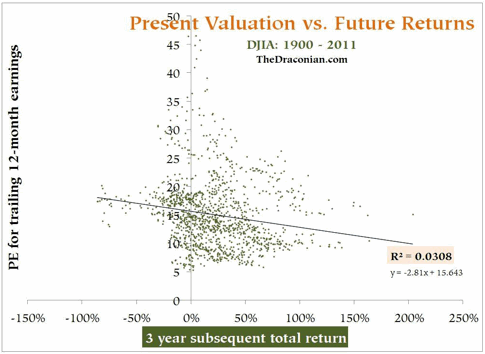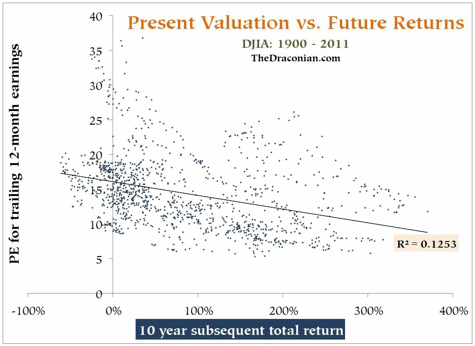There seems to be a never ending debate these days about the “value” of the market. The bulls cite trailing earnings to show low valuations while the bears generally cite forward earnings or cyclical data as evidence that the market might be expensive. I’ve never found much value in P/E ratios or other such “value” metrics for that matter. And honestly, unless you’re Warren Buffett or a hedge fund with access to the Board of Directors or other inside info you’re battling armies of analysts using the same metrics in the same manner. The odds of you finding a diamond in the rough using P/E ratios or similar valuation metrics is frankly, very low.
And now, an interesting bit of research from Draco Capital Management shows that investors might place far too much emphasis on the “value” of the market. In fact, their research shows that it’s nearly impossible to decipher future returns using present valuations (via Advisor Perspectives):
“But let me run you through a few charts that may raise some questions about your blind faith in the Price-to-Earnings multiple, the most popular way of measuring value.
What this first chart does is take a snapshot of the market’s P/E ratio on January 1, 1900. Then it fast-forwards three years to see how much money you made or lost if you made an investment in the Dow. Those two pieces of data become one little dot on our scatter-plot chart. I’ve plotted points for every month in the 20th and 21st centuries.”
“In this chart we’re relating present valuations to future returns. We’re checking to see if buying the stock market when it’s cheap translates into profits down the road.
Over a three year window, the data tell a fairly convincing story. Valuations matter a lot less than we’re comfortable admitting. As indicated by our regression line, there is a modest correlation between present valuation and future return, but with an R-squared of 0.03, it should be ignored. So there you go.
Over a 3-year window, there is no correlation between ttm P/E’s and the degree of future profitability.”
They ran the same data over a longer period. The results were pretty similar:
Let’s broaden our window a little further. Let’s widen our scope to 10 years. Does buying stocks when they are particularly cheap translate into more profitability for the coming decade?
“The visual correlation is a little more clear. Our R-squared is a bit higher but is it even at the level where it’s statistically meaningful? I’m still not sure I’m prepared to say that buying at lower multiples translates to higher profitability.
I feel good about saying one thing, though. There are few guarantees in this business, but — surprise! — if you buy stocks when they are craaazy cheap and can hold onto them for 10 years, the odds suggest you’ll make money.”
Their conclusion:
“1. Correlation between earnings multiples and subsequent returns is loose. Statistically speaking, it’s almost non-existent.
2. Unless you’re dealing with long holding periods, pretty much any outcome is in play. Markets that are historically cheap can get a lot cheaper and take a lot longer than most humans are comfortable waiting before swinging back into profitability.
3. In truth, this kind of analysis is only really useful during a few select moments in history. It’s only helpful at identifying extremes when the probabilities start to skew in the rational investor’s favor. The problem is that during those extremes is when the fewest number of investors are bothering with this type of analysis. They’re lost in all the other noise of the moment. They’re buying tech stocks in 2001 because, it’s the future, maaan! Or they’re cowering in their bunker in 1948. Or broke in 1933. Or high on the Nifty Fifty in 1965, among other interesting things.”
As they say, past results are not indicative of future returns. Beware of those data mining using the rear view mirror. These various valuation ratios might make the average financial advisor sound smarter than the average bear, but that doesn’t mean he/she is utilizing information that will necessarily lead to superior returns….
Mr. Roche is the Founder and Chief Investment Officer of Discipline Funds.Discipline Funds is a low fee financial advisory firm with a focus on helping people be more disciplined with their finances.
He is also the author of Pragmatic Capitalism: What Every Investor Needs to Understand About Money and Finance, Understanding the Modern Monetary System and Understanding Modern Portfolio Construction.



Comments are closed.